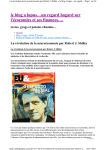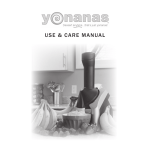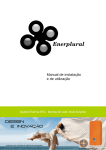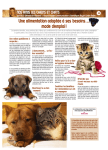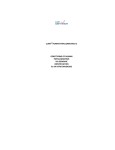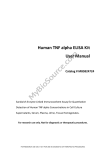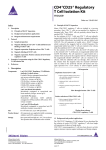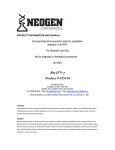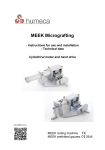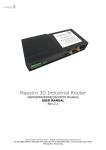Download Human IFN gamma ELISA Kit User Manual Catalog
Transcript
Human IFN gamma ELISA Kit Catalog # D^ϴϮϰϱϬϳ M yB io So ur ce .c o m User Manual Sandwich Enzyme-Linked Immunosorbent Assay for Quantitative Detection of Human IFN gamma Concentrations in Cell Culture Supernatants, Serum, Plasma, Urine, Tissue Homogenates. For research use only. Not for diagnostic or therapeutic procedures. -FOR RESEARCH USE ONLY. NOT FOR USE IN DIAGNOSTIC OR THERAPEUTIC PROCEDURES.- 1 I. INTRODUCTION.………………...............................................................……………………….2 II. ASSAY PRINCIPLES.....................................................................................................3 III. KIT COMPONENTS.………..............................................................……………………….…4 IV. STORAGE AND STABILITY.………........................………...................……………………….….4 V. MATERIALS REQUIRED BUT NOT PROVIDED.………………........................……….…….….5 VI. HEALTH AND SAFETY PRECAUTIONS…………......................................………….………..5 m VII. REAGENT PREPARATION………….......…………….............................................………....6 ce .c o VIII. ASSAY PROCEDURE................................…….......................................………………...9 IX. ASSAY PROCEDURE SUMMARY…..……………...…......................................................11 X. TYPICAL DATA……………..………...............……....................................................…….…12 ur XI. SENSITIVITY……………………................................................................…..….……...…12 So XII. SPECIFICITY……………......................................................................………………….…12 XIII. CROSS REACTIVITY………………..............................................................………………13 io XIV. REFERENCES……………................…………...……................……................................13 M yB XV. TROUBLESHOOTING GUIDE……………….………..........................................…………….14 -FOR RESEARCH USE ONLY. NOT FOR USE IN DIAGNOSTIC OR THERAPEUTIC PROCEDURES.- 2 I. INTRODUCTION Interferon-gamma (IFN-gamma) is an inflammatory cytokine that has been implicated in the development of fibrosis in inflamed tissues. The production of IFN-gamma, which is under genetic control, can influence the development of fibrosis in lung allografts. IFN-gamma is also produced by natural killer (NK) cells and most prominently by CD8 cytotoxic T cells, and is vital for the control of microbial pathogens. Interferon gamma is believed to be crucial for host defence against many infections. Genetically determined variability in IFN-gamma and expression might be m important for the development of tuberculosis. IFN-gamma activates human ce .c o macrophage oxidative metabolism and antimicrobial activity. In addition to having antiviral activity, IFN-gamma has important immunoregulatory functions. IFN-gamma M yB io So ur plays an important role in the control of neointima proliferation. -FOR RESEARCH USE ONLY. NOT FOR USE IN DIAGNOSTIC OR THERAPEUTIC PROCEDURES.- 3 II. ASSAY PRINCIPLES The Human IFN gamma ELISA (Enzyme-Linked Immunosorbent Assay) kit is an in vitro enzyme-linked immunosorbent assay for the quantitative measurement of Human IFN gamma in Cell Culture Supernatants, Serum, Plasma, Urine, Tissue Homogenates. This assay employs an antibody specific for Human IFN gamma coated on a 96-well plate. Standards and samples are pipetted into the wells and IFN gamma present in a sample is bound to the wells by the immobilized antibody. The wells are washed and biotinylated anti-Human IFN gamma antibody is m added. After washing away unbound biotinylated antibody, HRP-conjugated ce .c o streptavidin is pipetted to the wells. The wells are again washed, a TMB substrate solution is added to the wells and color develops in proportion to the amount of IFN gamma bound. The Stop Solution changes the color from blue to yellow, and the M yB io So ur intensity of the color is measured at 450 nm. -FOR RESEARCH USE ONLY. NOT FOR USE IN DIAGNOSTIC OR THERAPEUTIC PROCEDURES.- 4 III. KIT COMPONENTS Component Volume 12 x 8 Strips Human IFN gamma Standard 10 ng x 2 Biotin-Labeled Detection Antibody (100X) 120 µl Streptavidin-HRP (100X) 120 µl Standard/Sample Diluent 30 ml Detection Antibody Diluent 12 ml m 96-well Plate Coated With Anti-Human IFN gamma Antibody 12 ml ce .c o Streptavidin-HRP Diluent Wash Buffer (20X) TMB Substrate Solution Stop Solution ur Plate Adhesive Strips 12 ml 12 ml 3 Strips io 1 Manual yB STORAGE AND STABILITY M IV. So Technical Manual 30 ml All kit components are stable at 2 to 8 °C. Standard (recombinant protein) should be stored at -20 °C or -80 °C (recommended at -80 °C) after reconstitution. Opened Microplate Wells or reagents may be store for up to 1 month at 2 to 8 °C. Return unused wells to the pouch containing desiccant pack, reseal along entire edge. Note: the kit can be used within one year if the whole kit is stored at -20 °C. Avoid repeated freeze-thaw cycles. -FOR RESEARCH USE ONLY. NOT FOR USE IN DIAGNOSTIC OR THERAPEUTIC PROCEDURES.- 5 V. MATERIALS REQUIRED BUT NOT PROVIDED 1. Microplate reader capable of measuring absorbance at 450 nm. 2. Adjustable pipettes and pipette tips to deliver 2 µl to 1 ml volumes. 3. Adjustable 1-25 ml pipettes for reagent preparation. 4. 100 ml and 1 liter graduated cylinders. 5. Absorbent paper. 6. Distilled or deionized water. HEALTH AND SAFETY PRECAUTIONS ur VI. ce .c o 8. Tubes to prepare standard or sample dilutions. m 7. Computer and software for ELISA data analysis. So 1. Reagents provided in this kit may be harmful if ingested, inhaled or absorbed through the skin. Please carefully review the MSDS for each reagent before io conducting the experiment. yB 2. Stop Solution contains 2 N Sulfuric Acid (H 2 SO 4 ) and is an extremely corrosive agent. Please wear proper eye, hand and face protection when handling this material. M When the experiment is finished, be sure to rinse the plate with copious amounts of running water to dilute the Stop Solution prior to disposing the plate. -FOR RESEARCH USE ONLY. NOT FOR USE IN DIAGNOSTIC OR THERAPEUTIC PROCEDURES.- 6 VII. REAGENT PREPARATION 1. Sample Preparation Store samples to be assayed within 24 hours at 2-8°C. For long-term storage, aliquot and freeze samples at -20°C. Avoid repeated freeze-thaw cycles. Cell culture supernates: Remove particulates by centrifugation, assay immediately or aliquot and store samples at -20°C. Serum: Allow the serum to clot in a serum separator tube (about 4 hours) at room serum immediately or aliquot and store samples at -20°C. m temperature. Centrifuge at approximately 1000 X g for 15 minutes. Analyze the ce .c o Plasma: Collect plasma using heparin or EDTA as an anticoagulant. Centrifuge for 15 minutes at 1500 X g within 30 minutes of collection. Assay immediately or aliquot and store samples at -20°C. ur Cell Lysates: Collect cells and rinse cells with PBS. Homogenize and lyse cells So throughly in lysate solution. Centrifuge cell lysates at approximately 10000 X g for 5 minutes to remove debris. Aliquots of the cell lysates were removed and assayed. io Bone Tissue: Extract demineralized bone samples in 4 M Guanidine-HCl and protease yB inhibitors. Dissolve the final sample in 2 M Guanidine-HCl. Tissue Homogenates: Rinse tissue with PBS to remove excess blood, chopped into M 1-2 mm pieces, and homogenize with a tissue homogenizer in PBS or in lysate solution, lysate solution: tissue net weight = 10ml : 1g (i.e. Add 10ml lysate solution to 1g tissue). Centrifuge at approximately 5000 X g for 5 minutes. Assay immediately or aliquot and store homogenates at -20°C. Avoid repeated freeze-thaw cycles. Urine: Urinary samples should be cleared by centrifugation and then can be used directly without dilution. Storage at -20°C. 2. Human IFN gamma Standard Preparation Reconstitute the lyophilized Human IFN gamma Standard by adding 1 ml of Standard/Sample Diluent to make the 10000 pg/ml standard stock solution. Allow -FOR RESEARCH USE ONLY. NOT FOR USE IN DIAGNOSTIC OR THERAPEUTIC PROCEDURES.- 7 solution to sit at room temperature for 5 minutes, then gently vortex to mix completely. Use within one hour of reconstituting. Two tubes of the standard (10 ng per tube) are included in each kit. Use one tube for each experiment. Perform 2-fold serial dilutions of the top standards to make the standard curve within the range of this assay (15.6 pg/ml - 1000 pg/ml) as below. Standard/Sample Dilution Buffer serves as the zero standard (0 pg/ml). Standard Add Into 100 µl of the Standard (10000 pg/ml) 900 µl of the Standard/Sample Diluent 500 pg/ml 500 µl of the Standard (1000 pg/ml) 500 µl of the Standard/Sample Diluent 250 pg/ml 500 µl of the Standard (500 pg/ml) 500 µl of the Standard/Sample Diluent 125 pg/ml 500 µl of the Standard (250 pg/ml) 500 µl of the Standard/Sample Diluent 62.5 pg/ml 500 µl of the Standard (125 pg/ml) 500 µl of the Standard/Sample Diluent 31.25 pg/ml 500 µl of the Standard (62.5 pg/ml) 500 µl of the Standard/Sample Diluent 15.625 pg/ml 500 µl of the Standard (31.25 pg/ml) 500 µl of the Standard/Sample Diluent 0 ng/ml 1 ml of the Standard/Sample Diluent So ur ce .c o m 1000 pg/ml io Note: The standard solutions are best used within 2 hours. The 10000 pg/ml yB standard solution should be stored at 4°C for up to 12 hours, or at -20°C for up to 48 M hours. Avoid repeated freeze-thaw cycles. 3. Biotin-Labeled Detection Antibody Working Solution Preparation The Biotin-Labeled Detection Antibody should be diluted in 1:100 with the Detection Antibody Diluent and mixed thoroughly. The solution should be prepared no more than 2 hours prior to the experiment. 4. Streptavidin-HRP Working Solution Preparation The Streptavidin-HRP should be diluted in 1:100 with the Streptavidin-HRP Diluent and mixed thoroughly. The solution should be prepared no more than 1 hour prior to the experiment. -FOR RESEARCH USE ONLY. NOT FOR USE IN DIAGNOSTIC OR THERAPEUTIC PROCEDURES.- 8 5. Wash Buffer Working Solution Preparation Pour entire contents (30 ml) of the Wash Buffer Concentrate into a clean 1,000 ml graduated cylinder. Bring final volume to 600 ml with glass-distilled or deionized M yB io So ur ce .c o m water (1:20). -FOR RESEARCH USE ONLY. NOT FOR USE IN DIAGNOSTIC OR THERAPEUTIC PROCEDURES.- 9 VIII. ASSAY PROCEDURE The Streptavidin-HRP Working Solution and TMB Substrate Solution must be kept warm at 37°C for 30 minutes before use. When diluting samples and reagents, they must be mixed completely and evenly. Standard detection curve should be prepared for each experiment. The user will decide sample dilution fold by crude estimation of protein amount in samples. 1. Add 100 µl of each standard and sample into appropriate wells. m 2. Cover well and incubate for 90 minutes at room temperature or over night at 4°C ce .c o with gentle shaking. 3. Remove the cover, discard the solution and wash plate 3 times with Wash Buffer Working Solution, and each time let Wash Buffer Working Solution stay in the wells ur for 1 - 2 minutes. Blot the plate onto paper towels or other absorbent material. Do So NOT let the wells completely dry at any time. 4. Add 100 µl of Biotin-Labeled Detection Antibody Working Solution into each well io and incubate the plate at 37°C for 60 minutes. yB 5. Wash plate 3 times with Wash Buffer Working Solution, and each time let Wash Buffer Working Solution stay in the wells for 1 - 2 minutes. Discard the Wash Buffer M Working Solution and blot the plate onto paper towels or other absorbent material. 6. Add 100 µl of Streptavidin-HRP Working Solution into each well and incubate the plate at 37°C for 45 minutes. 7. Wash plate 5 times with Wash Buffer Working Solution, and each time let wash buffer stay in the wells for 1 - 2 minutes. Discard the wash buffer and blot the plate onto paper towels or other absorbent material. 8. Add 100 µl of TMB Substrate Solution into each well and incubate plate at 37°C in dark for 30 minutes. 9. Add 100 µl of Stop Solution into each well. The color changes into yellow immediately. -FOR RESEARCH USE ONLY. NOT FOR USE IN DIAGNOSTIC OR THERAPEUTIC PROCEDURES.- 10 10. Read the O.D. absorbance at 450nm in a microplate reader within 30 minutes after adding the Stop Solution. For calculation, (the relative O.D.450) = (the O.D.450 of each well) - (the O.D.450 of Zero well). The standard curve can be plotted as the relative O.D.450 of each standard solution (Y) vs. the respective concentration of the standard solution (X). The concentration of the samples can be interpolated from the standard curve. m Note: If the samples measured were diluted, multiply the dilution factor to the M yB io So ur ce .c o concentrations from interpolation to obtain the concentration before dilution. -FOR RESEARCH USE ONLY. NOT FOR USE IN DIAGNOSTIC OR THERAPEUTIC PROCEDURES.- 11 yB io So ur ce .c o m ASSAY PROCEDURE SUMMARY M IX. -FOR RESEARCH USE ONLY. NOT FOR USE IN DIAGNOSTIC OR THERAPEUTIC PROCEDURES.- 12 X. TYPICAL DATA The standard curve is for demonstration only. A standard curve must be run with yB SENSITIVITY M XI. io So ur ce .c o m each assay. The minimum detectable dose of Human IFN gamma is typically less than 2 pg/ml. XII. SPECIFICITY The Human IFN gamma ELISA Kit allows for the detection and quantification of endogenous levels of natural and/or recombinant Human IFN gamma proteins within the range of 15.6 pg/ml - 1000 pg/ml. -FOR RESEARCH USE ONLY. NOT FOR USE IN DIAGNOSTIC OR THERAPEUTIC PROCEDURES.- 13 XIII. CROSS REACTIVITY No detectable cross-reactivity with other relevant proteins. XIV. REFERENCES 1. Awad, M.; Pravica, V.; Perrey, C.; El Gamel, A.; Yonan, N.; Sinnott, P. J.; Hutchinson, I. V. CA repeat allele polymorphism in the first intron of the human interferon-gamma m gene is associated with lung allograft fibrosis. Hum. Immunol. 60: 343-346, 1999. ce .c o 2. Szabo, S. J.; Sullivan, B. M.; Stemmann, C.; Satoskar, A. R.; Sleckman, B. P.; Glimcher, L. H. Distinct effects of T-bet in T(H)1 lineage commitment and IFN-gamma production in CD4 and CD8 T cells. Science 295: 338-342, 2002. ur 3. Rossouw, M.; Nel, H. J.; Cooke, G. S.; van Helden, P. D.; Hoal, E. G. Association So between tuberculosis and a polymorphic NF-kappa-B binding site in the interferon gamma gene. Lancet 361: 1871-1872, 2003. io 4. Nathan, C. F.; Murray, H. W.; Wiebe, M. E.; Rubin, B. Y. Identification of yB interferon-gamma as the lymphokine that activates human macrophage oxidative metabolism and antimicrobial activity. J. Exp. Med. 158: 670-689, 1983. M 5. Zohlnhofer, D.; Richter, T.; Neumann, F. -J.; Nuhrenberg, T.; Wessely, R.; Brandl, R.; Murr, A.; Klein, C. A.; Baeuerle, P. A. Transcriptome analysis reveals a role of interferon-gamma in human neointima formation. Molec. Cell 7: 1059-1069, 2001. -FOR RESEARCH USE ONLY. NOT FOR USE IN DIAGNOSTIC OR THERAPEUTIC PROCEDURES.- 14 TROUBLESHOOTING GUIDE Problem Possible Cause High signal and background in all wells • Insufficient washing • Increase number of washes • Increase time of soaking between in wash • Too much Streptavidin-HRP • Check dilution, titration • Incubation time too long • Reduce incubation time • Development time too long • Decrease the incubation time before the stop solution is added • Reagent added in incorrect order, or incorrectly prepared • Review protocol • Standard has gone bad (If there is a signal in the sample wells) • Check the condition of stored standard • Assay was conducted from an incorrect starting point • Reagents allows to come to 20 - 30 °C before performing assay • Increase number of washes Carefully • Too much Streptavidin-HRP • Check dilution • Plate sealer or reservoir reused, resulting in presence of residual Streptavidin-HRP • Use fresh plate sealer and reagent reservoir for each step Standard curve achieved but poor discrimination between point • Plate not developed long enough • Increase substrate solution incubation time • Improper calculation of standard curve dilution • Check dilution, make new standard curve No signal when a signal is expected, but standard curve looks fine • Sample matrix is masking detection • More diluted sample Recommended Samples are reading too high, but standard curve is fine • Samples contain protein levels above assay range • Dilute samples and run Again Edge effect • Uneven temperature around work surface • Avoid incubating plate in areas where environmental conditions vary • Use plate sealer So • Insufficient washing-unbound Streptavidin-HRP remaining M yB io Too much signal-whole plate turned uniformly blue ur ce .c o No signal Solution m XV. -FOR RESEARCH USE ONLY. NOT FOR USE IN DIAGNOSTIC OR THERAPEUTIC PROCEDURES.- 15















